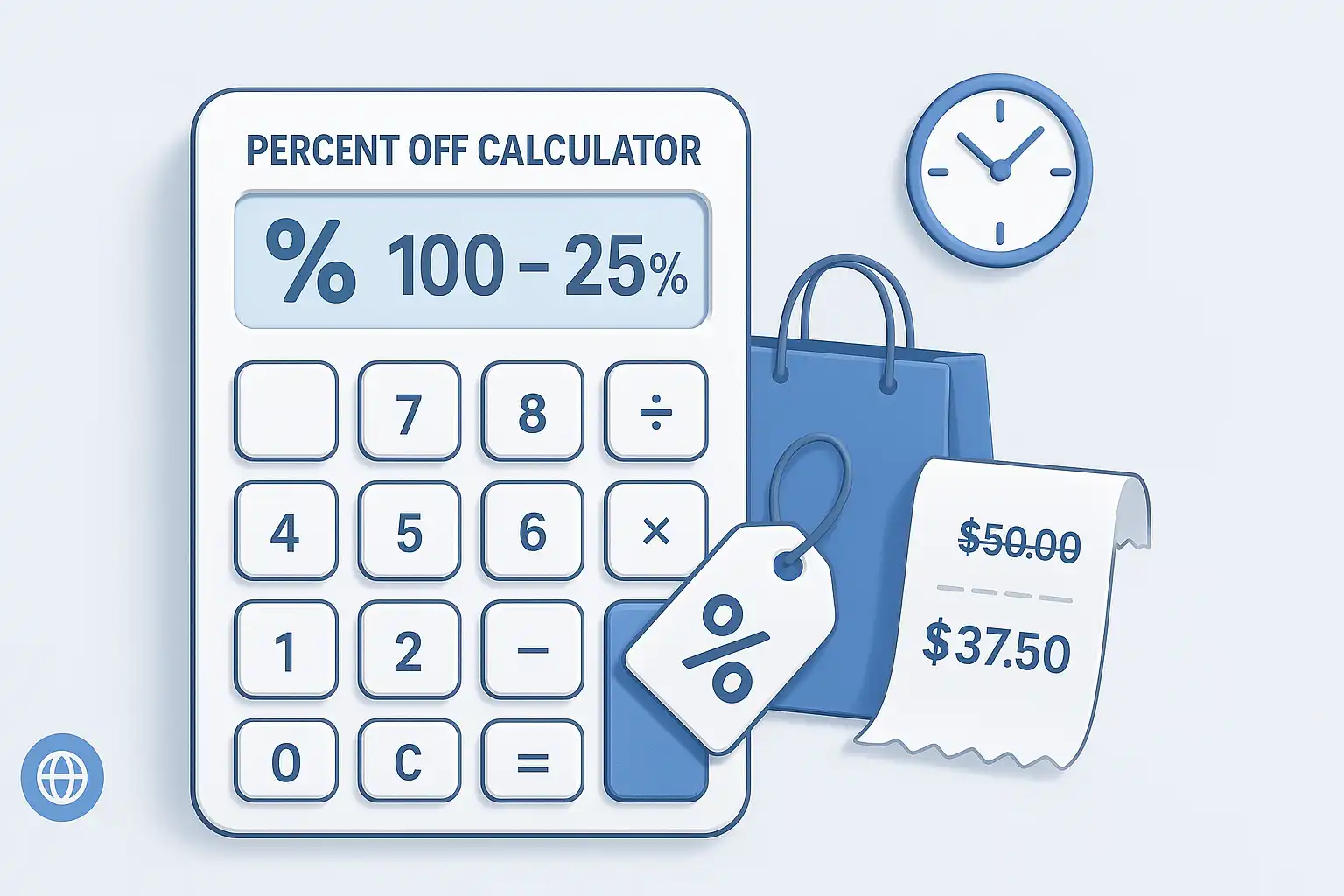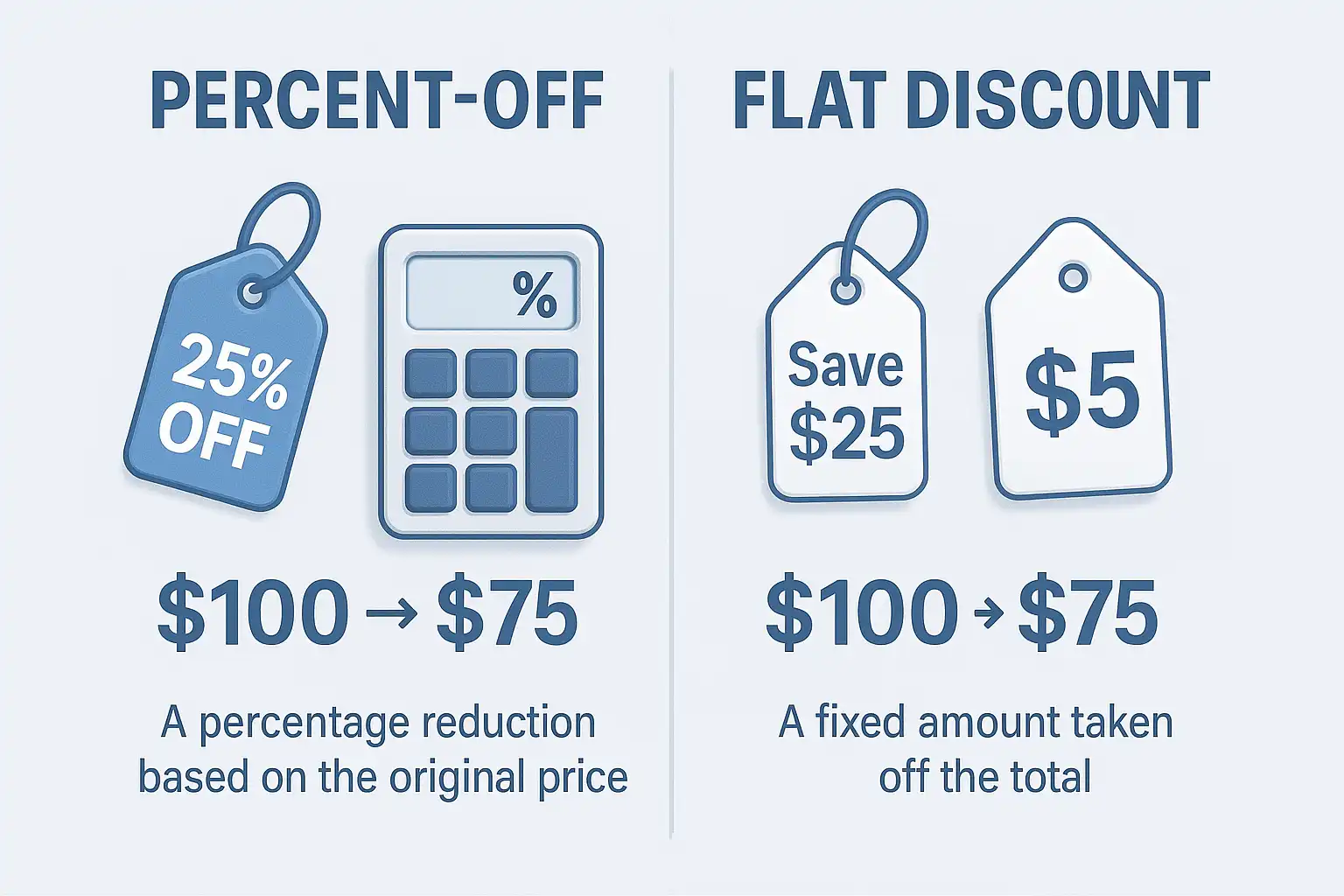percent off calculator

Want to know how much you’re really saving at checkout? Whether you’re shopping online or hunting in-store deals, a percent off calculator takes the guesswork out of discounts. In seconds, you’ll know the exact price after discount, how much you’re saving, and whether a stacked coupon is worth it. Let’s break down the math, so your wallet comes out winning.
What Is a Percent Off Calculator?
A percent off calculator is a simple tool that helps you figure out how much money you’ll save when an item is on sale. By entering the original price and the discount percentage, the calculator instantly shows you the amount saved and the final price after the discount.
For example, if something costs $80 and it’s 25% off, the calculator will tell you that you save $20—and your final price is $60. This eliminates guesswork during shopping and helps you compare deals more easily.
How to Calculate Percent Off
Calculating a percent off discount is easy when you follow a simple formula:
Final Price = Original Price – (Original Price × Percent Off)
Let’s break it down with an example from the calculator above:
- Original Price: $39.99
- Percent Off: 15% → Convert to decimal = 0.15
- Multiply: $39.99 × 0.15 = $6.00
- Subtract: $39.99 – $6.00 = $33.99
So, if you’re getting 15% off a $39.99 item, you’re saving $6.00, and your final price is $33.99.
Quick Reference Table: Percent Off Calculation Example
| Step | Description | Result |
|---|---|---|
| Original Price | Starting price before discount | $39.99 |
| Discount % | Percent off converted to decimal (15% = 0.15) | 0.15 |
| Discount Amount | $39.99 × 0.15 | $6.00 |
| Final Price After Discount | $39.99 – $6.00 | $33.99 |
Using a percent off calculator like the one shown helps you instantly find your final price and savings amount, especially during quick shopping decisions or when comparing stacked discounts.
Stackable Discounts Explained with Examples
Stackable discounts are when multiple percent-off offers apply in sequence, not added together. This can be confusing, but knowing how to calculate it helps you spot real savings.
Important: You apply each discount one at a time, using the reduced price as the new base.
Example:
Let’s say a jacket is $200, with two stackable discounts: 30% off, then 10% off.
- First discount: $200 × 0.30 = $60 → $200 – $60 = $140
- Second discount: $140 × 0.10 = $14 → $140 – $14 = $126 final price
Total savings: $74
Effective discount: 37%, not 40%
I remember shopping a holiday sale “25% off, then extra 20%.” I assumed it meant 45% off, but when I did the math, the total discount was closer to 40%. Still a win, but not what the sign made it seem!
Use a calculator or follow the steps above to make sure you’re getting what the promo promises.
What percent off calculator is great for
Inter Calculator’s percent off calculator is a handy tool that helps users determine how much they’ll pay after a discount is applied. It’s especially useful in everyday shopping scenarios, business pricing strategies, and basic financial planning.
If you’re dealing with promotions that offer fixed dollar discounts, we recommend using InterCalculator’s Discount Calculator to handle those values with equal ease.
Who It’s Great For:
Shoppers:
Quickly calculate sale prices during in-store or online shopping.
- Find final prices after percent discounts (e.g., 30% off $120)
- Compare discounted items side-by-side
- Use during seasonal sales like Black Friday or Cyber Monday
Retailers & Business Owners:
Check effective pricing and optimize promotional strategies.
- Estimate final sale prices and profit margins
- Test stackable discounts (e.g., 20% off, then 10% off again)
- Clarify percentage-based pricing for marketing
Coupon & Deal Seekers:
Evaluate savings from various discount types.
- Use for BOGO (Buy One Get One) or bulk offers
- Calculate savings from fixed or percentage coupons
- Analyze bundle discounts or loyalty rewards
Students & Finance Learners:
Great for practicing real-world math and understanding percentages.
- Visualize price reductions and savings clearly
- Reverse-engineer original prices from sale amounts
- Learn concepts like percentage decrease and value difference
What’s the difference between a percent-off and a discount?
What Is “Percent Off”?
Percent off is a way to show how much money you save on a product by removing a certain percentage from its original price. For example, if an item is $100 and you get 20% off, you save $20 and pay only $80. It’s a quick method to calculate discounts during sales or promotions.
Percent Off Example
- You’re buying a jacket that costs $100.
- There’s a 25% off sale.
Results
- 25% of $100 = $25
- Final price = $100 – $25 = $75
What Is ” Discount”?
A discount is a reduction in the price of a product or service. It can be a percentage off (like 20%) or a fixed amount (like $10 off). Discounts are commonly used in sales, promotions, or special offers to encourage purchases and help customers save money.
According to the Consumer Financial Protection Bureau (CFPB), calculating percentage‑based values, such as discounts or tips, follows a clear formula: multiply the total (or original) amount by the percentage expressed in decimal form. For example, a 15% tip on a $27 bill is calculated as $27 × 0.15 = $4.05. This same principle applies directly to percent-off calculations.
Discount Example
- A store offers $15 off any purchase over $75.
- You buy something that costs $90.
Results:
- $90 – $15 = $75
- This is a fixed discount, not a percentage.
Psychological & Strategic Aspects of Discounts
Psychological Aspects:
Discounts influence how people feel about spending money. When shoppers see a price drop, it creates a sense of satisfaction and excitement. They feel like they’re making a smart choice and saving money, which encourages them to buy faster.
Limited-time discounts also trigger urgency. People worry they might miss out, so they act quickly. This emotional pressure often leads to impulse purchases, even for items they didn’t plan to buy. The original price also acts as an anchor, making the discounted price look even better.
Strategic Business Use:
Businesses use discounts to increase sales, attract customers, and clear out inventory. They can plan discounts around holidays or seasons to boost traffic and revenue during specific times.
Flash sales or short-term offers are great for driving quick action. First-time buyer discounts help turn visitors into customers, while bundle or multi-buy deals encourage people to spend more in one transaction. Discounts are a smart way to shape buying behavior and hit business goals without lowering overall value.
Real-World Examples of Using a Percent Off Calculator
1. Clothing Sale:
A jacket is priced at $120, and the store is offering 30% off.
Using the percent off calculator:
- 30% of $120 = $36
- Final price = $120 – $36 = $84
2. Electronics Deal:
A laptop originally costs $800, and there’s a 15% discount during a weekend sale.
The calculator shows:
- 15% of $800 = $120
- Final price = $800 – $120 = $680
3. Grocery Store Promo:
A pack of snacks is $10, and a loyalty card gives you 10% off.
Calculator result:
- 10% of $10 = $1
- Final price = $10 – $1 = $9
4. Online Shopping Discount Code:
You’re buying shoes for $75 and applying a 20% off promo code.
The calculator gives:
- 20% of $75 = $15
- Final price = $75 – $15 = $60
5. Stackable Discounts:
A bag costs $100 with two offers: 20% off, then an extra 10% off.
Step-by-step with the calculator:
- First 20% off: $100 – $20 = $80
- Then 10% off: $80 – $8 = $72 final price
Why We Built This Tool
At InterCalculator, we noticed how often shoppers misjudge discounts, especially with stacked offers, unclear promotions, or confusing final prices at checkout. Whether it’s an online flash sale or an in-store clearance rack, understanding how much you’re actually saving shouldn’t require a math degree.
That’s why we built this percent-off calculator: to make discount math instant, transparent, and stress-free. Our goal is to help everyday users, deal hunters, and business owners get fast, accurate answers, so you can focus on smart spending instead of second-guessing markdowns. It’s part of our mission to turn financial calculations into tools anyone can use confidently in real life.
Final Thoughts
Understanding how percent-off discounts work helps you make smarter shopping choices. Whether you’re comparing deals, stacking promotions, or calculating savings in real time, a simple formula or a reliable calculator can make all the difference. With just a few quick steps, you can avoid misleading markdowns and feel more confident about every purchase.
Frequently Asked Questions
Got questions? Our FAQs cover common topics about how our tools work, tips for accurate calculations, and guidance on using InterCalculator for everyday money decisions.
A Percent Off Calculator shows the reduced price of an item after applying a percentage discount. It instantly tells you both the savings amount and the final price.
A percent-off discount reduces the price by a percentage, while a fixed discount subtracts a set dollar amount. For example, 20% off $100 saves you $20, but a $20-off coupon always saves the same amount.
Yes, you can calculate multiple percent-off deals by applying them one after the other. For instance, a 30% discount followed by an extra 10% discount is not the same as 40% off—our calculator helps you see the exact price.
Absolutely. Whether you’re calculating savings on groceries or high-ticket items like electronics, the calculator works the same way for any purchase amount.
When discounts are applied one after another, the second discount applies to the already reduced price, not the original price. This is why the total savings is slightly less than adding the percentages together.
Created by Editorial Team
The Percent Off Calculator was created by the InterCalculator Editorial Team, led by Haris Farooq (Formula & Development). With expertise in percentage formulas, discount logic, and technical development, our team built this tool to help shoppers and businesses quickly figure out sale prices and savings.
Accuracy Review Process:
Before publishing, every calculator goes through the InterCalculator Accuracy Review Process. For the Percent Off Calculator, we verify formulas against trusted retail pricing and percentage calculation standards. We test results across multiple shopping and discount scenarios to ensure accurate and practical outputs. All calculations are reviewed with an experienced pricing analyst to confirm accuracy, clarity, and reliability.
